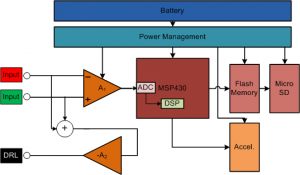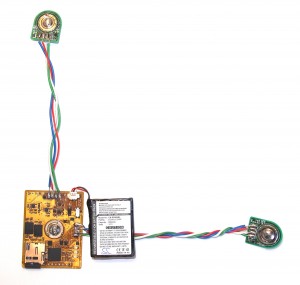A Wearable, Long-term Cardiac Monitor
- Category: Circuits & Systems, Medical Electronics
- Tags: charles sodini, eric winokur, healthcare, margaret delano
With the escalating costs of hospital visits, clinicians are opting to use at-home monitoring devices to diagnose patients. Current ECG Holter monitoring devices typically have 24-48 hour memory and battery capacity [1] . With many patients experiencing intermittent heart problems that can occur once every week or month, an event recorder or loop recorder is required [2] . However, event recorders can save only up to a few minutes of ECG recordings. This constraint leads to the loss of most of the data, which could be very important in alerting the user to the onset of future episodes. Therefore, we have developed a Holter monitor prototype with the goal of battery and memory capacity of greater than one week. Figure 1 shows a block diagram of the system.
We based the long-term monitor prototype around a Texas Instruments MSP430 low-power microcontroller that enables high computing power with very low power consumption. The prototype monitor is mounted on standard 3M 2560 Red Dot electrodes. The central board is fabricated on a flexible PCB substrate. Mounting the PCB directly on the electrodes improves the SNR by an estimated 40 dB compared to using wired leads [3] . The monitor is “L”-shaped with rounded corners and placed on the patient’s chest (Figure 2). The “L” shape enables several different ECG vectors to be recorded, depending on what the cardiologist wants to observe. The monitor has a micro SD card on board, which is enough to store weeks of ECG data sampled at 250 Hz continuously, without compression.
- Figure 1: Block diagram of the ECG long-term Holter monitor system. The front end uses TI OPA333 and INA333 amplifiers and has a bandwidth from 0.5 Hz to 125 Hz. The 3-axis ADI accelerometer samples data at 12.5Hz to help correlate activity level with the ECG recordings. The battery is a 3.7V 600 mAh Li-Pol cell from Cameron-Sino.
- Figure 2: A photo of the wearable, long-term cardiac monitor. The monitor is coated in Parylene C to protect it from water and sweat that may come in contact with the circuits.
- D. Jabaudon, J. Sztajzel, K. Sievert, T. Landis, and R. Sztajzel, “Usefulness of ambulatory 7-day ECG monitoring for the detection of atrial fibrillation and flutter after acute stroke and transient ischemic attack,” Stroke, J. Amer. Heart Assoc., vol. 35, pp. 1647–1651, May 2004. [↩]
- M. A. Rockx, J. S. Hoch, G. J. Klein, R. Yee, A. C. Skanes, L. J. Gula, and A. D. Krahn, “Is ambulatory monitoring for “Community-acquired” syncope economically attractive? A cost-effective analysis of a randomized trial of external loop recorders versus Holter monitoring,” AHJ vol. 150, no. 5, pp. 1065.e1-1065.e5, Nov. 2005. [↩]
- A. Searle and L. Kirkup, “A direct comparison of wet, dry and insulating bioelectric recording electrodes,” Physiol. Meas., vol. 21, pp. 271-283, 2000. [↩]

